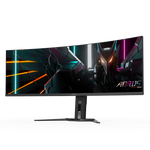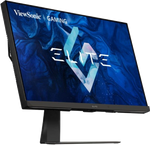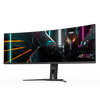What we think

If you prioritize immersive HDR gaming and media consumption with deep blacks and vibrant colors, the Gigabyte CO49DQ with its larger screen and OLED technology will be very impressive. However, it's not as well-suited for productivity due to its large size and aspect ratio, which some might find overwhelming. On the other hand, the ViewSonic XG321UG, with a more traditional aspect ratio and smaller size, would be better for productivity and digital photo editing but may not provide the same level of immersion in gaming and media viewing. It's also worth noting that while the ViewSonic is more expensive, it offers a high peak brightness and more uniformity in brightness, which is beneficial for well-lit environments and consistent color work. Choose the Gigabyte if gaming and media are your focus and you're looking for a more budget-friendly option, or the ViewSonic for high-level photo editing and a more standard size for mixed-use. Give Feedback
- Best in class for casual gaming
- Best in class for media consumption
- Best in class contrast
- Best in class brightness
- Best in class color volume
- Best in class response time
- Good for productivity
- Good text clarity
- Good image clarity
Key differences
Casual Gaming


Competitive Gaming


Productivity


Media Consumption


Cost


$0
$500
$1,000
$1,500
$2,000
$2,500
$3,000
$3,500
HDR Gaming and Media Consumption


Digital Photo Editing


HDR Video Editing and Color Grading


Key similarities
Print Photo Editing


Give feedback
How the Gigabyte CO49DQ (QD-OLED) and the ViewSonic XG321UG (IPS Mini LED) compare to other monitors
Spec Comparison
| Gigabyte CO49DQ (QD-OLED) | ViewSonic XG321UG (IPS Mini LED) |
GENERAL | |||
|---|---|---|---|
| Price | |||
$900 | $2,300 | ||
Screen Size | |||
Screen Size | 49" | 32" | |
Resolution | |||
Resolution | 5120 x 1440 | 3440 x 2160 | |
Screen Type | |||
Screen Type | OLED | Mini LED | |
Screen Sub-type | |||
Screen Sub-type | QD-OLED | IPS | |
Local Dimming Zones | |||
Local Dimming Zones | N/A | 1152 | |
COLOR, CONTRAST & BRIGHTNESS | |||
|---|---|---|---|
Native Contrast | |||
Native Contrast | Inf:1 | 1000:1 | |
SDR Peak Brightness | |||
SDR Peak Brightness | 1000 nits | 400 nits | |
HDR Peak Brightness | |||
HDR Peak Brightness | Unknown | 1400 nits | |
Suitable for HDR Gaming and Media Consumption | |||
Suitable for HDR Gaming and Media Consumption | Yes | No | |
sRGB Color Gamut | |||
sRGB Color Gamut | 153.1 % | ||
MOTION CHARACTERISTICS | |||
|---|---|---|---|
Total Response Time | |||
Total Response Time | 0.03 ms | 3.6 ms | |
Variable Refresh Rate | |||
Variable Refresh Rate | 48 - 144 Hz | 48,144 Hz | |
Strobing / BFI | |||
Strobing / BFI | No | No | |
Persistence Blur Score | |||
Persistence Blur Score | 6.6/10 | 6.6/10 | |
Ghosting Score | |||
Ghosting Score | 10/10 | 8.4/10 | |
TEXT & IMAGE CLARITY | |||
|---|---|---|---|
Pixels Per Inch | |||
Pixels Per Inch | 108 PPI | 137 PPI | |
Coating | |||
Coating | Matte | Matte | |
Text Clarity Score | |||
Text Clarity Score | 6.6/10 | 7.9/10 | |
Image Clarity Score | |||
Image Clarity Score | 7/10 | 7.9/10 | |
PORTS & CONNECTIVITY | |||
|---|---|---|---|
HDMI 1.4 Ports | |||
HDMI 1.4 Ports | 0 | 0 | |
HDMI 2.0 Ports | |||
HDMI 2.0 Ports | 0 | 2 | |
HDMI 2.1 Ports | |||
HDMI 2.1 Ports | 2 | 0 | |
Micro HDMI Ports | |||
Micro HDMI Ports | 0 | 0 | |
DisplayPort 1.2 Ports | |||
DisplayPort 1.2 Ports | 0 | 0 | |







